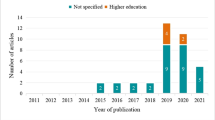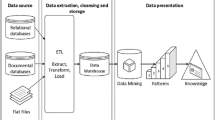Abstract
To improve students' performance effectively, many Chinese universities are establishing systems to predict student's academic performance and sending student's academic early alerts. With student's population of over 600,000, Chinese-foreign cooperation in running schools (CFCRS) has become one of the booming higher education forms in China. Compared with students in the non-cooperatively running programs, CFCRS students' academic performances are weaker on average. To predict the academic-at-risk students and provide efficient supports to the students, a precise and prompt academic prediction is in great need. Therefore, this research aims at representing a more efficient and accurate model to predict academic performance of CFCRS students which will be based on graph convolutional network. In this research, student's similarity is measured on academic performance by Pearson correlation coefficient. An undirected graph in which similar students are connected is conducted. Feature matrix is composed of students' previous grades. In addition, graph convolutional network is trained based on the undirected graph and feature matrix. In the experiment, it shows that this model predicts certain student's performance on certain course from the final exam results in previous semesters, which might improve learning efficiency and teaching quality. With an average accuracy of 81.5%, graph convolutional network outperforms support vector machine and random forest models.





Similar content being viewed by others
References
Sheng-dong L (2011) The research and design of monitoring-early warning system for college students' school work. Mod Educ Technol 21(10):106–108
Karaci A (2019) Intelligent tutoring system model based on fuzzy logic and constraint-based student model. Neural Comput Appl 31:3619–3628
Naidoo A, Lemmens JC (2015) Faculty intervention as support for first-year students. J Stud Aff Afr 3(2):17–32
Livieris IE, Kotsilieris T, Tampakas V et al (2019) Improving the evaluation process of students' performance utilizing a decision support software. Neural Comput Appl 31:1683–1694
Kong J, Han J, Ding J et al (2020) Analysis of students' learning and psychological features by contrast frequent patterns mining on academic performance. Neural Comput Appl 32:205–211
Yun-hai W, Yan H, Mei L (2008) Research on issues of Sino-foreign cooperation education. Int Bus 2008(S1):78–82
Liu X (2007) Sino-foreign cooperation of school running: issues and wayout. J Guangxi Normal Univ Philos Soc Sci Ed 2007(05):85–89
Wu W, Luo J (2016) A study on undergraduates' satisfaction with Chinese-foreign cooperative program of independent college. Res High Educ Eng 2016(01):82–86+148
He J, Li G (2009) The core issues of Sino-foreign cooperative in running schools. China High Educ Res 2009(05):88–89
Yubo L (2015) An analysis of status of the development of China's international education projects. J Chin Soc Educ 2015(S1):261–262
Essa A, Ayad H (2012) Student success system: risk analytics and data visualization using ensembles of predictive models. In: International conference on learning analytics and knowledge. ACM
Pistilli MD, Arnold KE (2010) In practice: purdue signals: mining real-time academic data to enhance student success. About Campus 15(3):22–24
Romero C, López M-I, Luna J-M, Ventura S (2013) Predicting students' final performance from participation in on-line discussion forums. Comput Educ 68:458–472
Liu B-P, Fan T-C, Yang H (2019) Research on application of early warning of students' achievement based on data mining. J Sichuan Univ (Nat Sci Ed) 56(02):267–272
Hua W, Liu P (2015) Application of improved association rule algorithm in early warning of student performance. Comput Eng Des 36(03):679–682+752
Czibula G, Mihai A, Crivei LM (2019) S PRAR: a novel relational association rule mining classification model applied for academic performance prediction. Procedia Comput Sci 159:20–29
Fernandes E, Holanda M, Victorino M, Borges V, Carvalho R, Van Erven G (2019) Educational data mining: predictive analysis of academic performance of public school students in the capital of Brazil. J Bus Res 94:335–343
Gray CC, Perkins D (2019) Utilizing early engagement and machine learning to predict student outcomes. Comput Educ 131:22–32
Liao ZY, Fu XF, Wang YG (2012) The research of improved Apriori algorithm. Appl Mech Mater 263–266:2179–2184
Gang-sheng L, Tie-gang G, Liu X, Hai-bo Y (2018) Research on the learning difficulty students forecasting based on extreme learning machine. Mod Educ Technol 28(04):34–40
Waheed H, Hassan S-U, Aljohani NR, Hardman J, Alelyani S, Nawaz R (2020) Predicting academic performance of students from VLE big data using deep learning models. Comput Hum Behav 104:106189
Hoang SL, Hamido F (2018) Neural-fuzzy with representative sets for prediction of student performance. Appl Intell 49:172–187
Kipf TN, Welling M (2017) Semi-supervised classification with graph convolutional networks. In: International conference on learning representations
Choi J, Peters M, Mueller RO (2010) Correlational analysis of ordinal data: from Pearson's r to Bayesian polychoric correlation. Asia Pac Educ Rev 11(4):459–466
Whitfield CF, Xie SX (2002) Correlation of problem-based learning facilitators' scores with student performance on written exams. Adv Health Sci Educ 7(1):41–51
Ibrahim AA (2009) Association between scores in high school, aptitude and achievement exams and early performance in health science college. Saudi J Kidney Dis Transplant 20(3):448
Bruna J, Zaremba W, Szlam A, LeCun Y (2014) Spectral networks and deep locally connected networks on graph. In: International conference on learning representations
Defferrard M, Bresson X, Vandergheynst P (2016) Convolutional neural networks on graphs with fast localized spectral filtering. In: Conference and workshop on neural information processing systems
Kingma D, Ba J (2015) Adam: a method for stochastic optimization. In: International conference on learning representations
Garcia V, Bruna J (2018) Few-shot learning with graph neural networks. In: International conference on learning representations
Funding
Teaching Reform Research Project of Undergraduate Colleges and Universities of Shandong Province (Z2016Z036), the Teaching Reform Research Project of Shandong University of Finance and Economics (jy2018062891470, jy201830, jy201810), Shandong Provincial Social Science Planning Research Project (18CHLJ08), Scientific Research Projects of Universities in Shandong Province (J18RA136), Youth Innovative on Science and Technology Project of Shandong Province (2019RWF013), SDUST Excellent Teaching Team Construction Plan (JXTD20160512 and JXTD20180510), Jinan campus of SDUST Excellent Teaching Team Construction Plan (JNJXTD201711), Teaching research project of Shandong University of Science and Technology (JNJG2017104), National Natural Science Foundation of China (61703243).
Author information
Authors and Affiliations
Corresponding author
Ethics declarations
Conflict of interests
The authors declare that they have no competing interests among authors.
Additional information
Publisher's Note
Springer Nature remains neutral with regard to jurisdictional claims in published maps and institutional affiliations.
Rights and permissions
About this article
Cite this article
Hai-tao, P., Ming-qu, F., Hong-bin, Z. et al. Predicting academic performance of students in Chinese-foreign cooperation in running schools with graph convolutional network. Neural Comput & Applic 33, 637–645 (2021). https://doi.org/10.1007/s00521-020-05045-9
Received:
Accepted:
Published:
Issue Date:
DOI: https://doi.org/10.1007/s00521-020-05045-9




